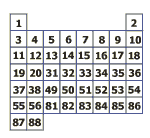 Atomic number
Atomic number
The atomic number of a given element corresponds to the number of protons in the respective atomic nuclei.
Electrically neutral atoms contain equal number of electrons (in the sheath) and protons (in the atomic nucleus). Because the electronic sheath determines the chemical characteristics of atoms, all atoms with the same atomic number (the same number of protons and electrons respectively) are chemically identical – they make part of the same chemical element.
When the elements are ordered according to their atomic number, elements with similar chemical characteristics are arranged in a more or less regular way. In the periodic system, elements with similar chemical characteristics are arranged in columms. The simplified form of presentation shown here only refers to the most important elements. The regularity of chemical characteristics is due to the laws of (quantum mechanics) regarding the electronic sheath.